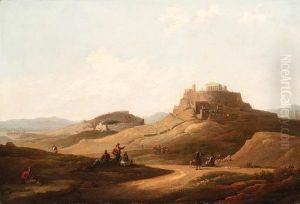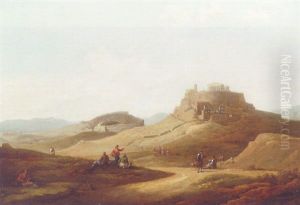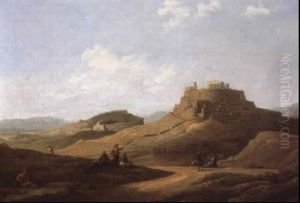Charles Fellows Paintings
Sir Charles Fellows was a renowned British explorer and archaeologist known for his extensive work and discoveries related to the ancient civilizations of Asia Minor, particularly Lycia in present-day Turkey. Born in August 1799 in Nottingham, England, Fellows had an interest in antiquities and ancient civilizations from a young age, which would later shape his career and contributions to archaeology.
Fellows' most notable expeditions took place in the 1830s and 1840s, when he traveled to Lycia, an area that had not been extensively explored by Europeans at the time. His first journey to Lycia was in 1838, where his interests were initially in the picturesque and the adventure of travel rather than systematic archaeological study. However, he quickly developed a methodical approach to his explorations and discoveries.
During his expeditions, Fellows meticulously documented Lycian tombs, ruins, architecture, and inscriptions, contributing significantly to the understanding of the region's history and culture. His work led to the identification of many Lycian cities, and he was the first to distinguish Lycian script from other ancient writing systems. One of his most significant contributions was the discovery of the Nereid Monument, a large and elaborately decorated tomb which he identified in Xanthos.
Fellows' archaeological findings were published in several works, which brought him recognition and esteem among scholars and the British public. His publications included 'An Account of Discoveries in Lycia, a Journal Kept During a Second Excursion in Asia Minor' in 1841 and 'A Journal Written During an Excursion in Asia Minor' in 1839. His work impressed the British government and Royal Society, leading to a government-sponsored expedition in 1841 to bring Lycian artifacts back to Britain. As a result of his successful endeavors, Fellows was knighted in 1845.
The artifacts Fellows helped to bring back to England became part of the collection of the British Museum, including the Nereid Monument, which remains one of the museum's most significant and visited Lycian exhibits. Sir Charles Fellows continued to travel and write until his health declined. He passed away on November 8, 1860, leaving behind a legacy of pioneering archaeological exploration and a substantial contribution to the understanding of ancient Lycian civilization.


